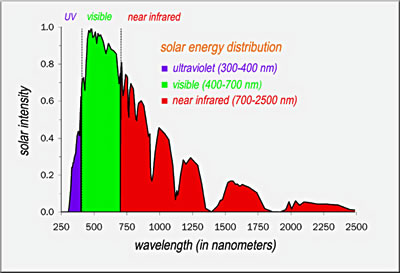No I'm not mistaken as never said sunlight was IR, although the wings of the distribution have more IR than UV.No, you are mistaken. Most of the solar radiation we receive at the surface of the Earth is NOT IR radiation.

Molecular absorption is quite wave length selective as energy must be conserved and the only "after absorption" place to take up a continuum of energy (kinetic) is the molecular recoil, but momentum must be conserved too. Thus the tiny momentum of the photon changes the speed of the heavy molecule only slightly. As the kinetic energy goes as the square of the speed, most of the photon's energy is internally stored in an excited state of the molecule. (Usually only briefly as the stored energy is re-radiated, unless the gas is very dense. Then it heats the gas via collisional de-excitation of the excited state.)
UV can split molecular bond (or even ionized). The sun is quite a good approximation of a black body, but the UV wing intensity falls off more rapidly than the black body curve. This is because there are more particles after the typical UV absorption to conserve both energy and momentum, so any wavelength photon can be absorbed.
You can see that the absorption "notches" in the far IR are broader. This is mainly due to fact the molecules had a larger spread of kinetic energy relative to the far IR photon. If it was moving towards the incoming photon from its point view the photon has more energy (Doppler shift) and will not have the correct energy to make the transition to the higher state, but some lower energy photon will. Conversely if it is moving away then the photon it can absorb must have higher energy. - That is Part of the reason why those far IR notches are broader then the near IR ones are. A larger reason is due to something called "collisional broading." I won't try to explain that to you. I know more about all this than most physics PH. D.s do as my Ph.D. thesis was on the shift and broading of spectral lines from an ionized radiator (Argon II lines in a dense plasma. The first to measure this for ANY ion with collisional broading dominating the Doppler broading. Hans Griem's theory only applied to lines from neutral radiators, but he was trying to extend it to a ionized radiator).
SUMMARY: Given that I know much more about this than you or 99.99% of the population does, I don't need ANY correction, especially as I never said most of the sunlight is IR. What my "IR opaque" clearly referred to is that the surface radiation trying to escape to space could not directly do so when Earth has a completely covering high altitude cloud cover, like Venus does.
BTW the clouds are nearly IR opaque even for the sunlight, but the dominate mechanism is scattering (the refraction form of scattering mainly), not absorption. This is why clouds "reflect" sunlight. I.e. they have multiply scatteed the photons until the net result of many random changes in their direction of travel sends them back out of the cloud.* For the longer wave length IR when wave length is about same as water droplet size, that scattering should not be called refraction. It becomes Mie scattering, quite complex but interesting - sort of more self interference off the droplet surfaces and thus very slightly different wave lengths constructively interfere in quite different "reflection directions." Less and 99.9999% percent of the population have even heard of Mie scattering, I bet, much less have been thru its math.
* This multiple scattering form of reflection can have a greater coefficient of reflection than any metal but the scatters must have essentially zero absorption. Sodium Iodide crystals make excellent scintillators to detect gamma rays but the photon produced is very likely to leave the crystal at some location where the detecting photo-multiplier tube is not. It must be very efficiently reflected back into the crystal many times before it strikes the photo-multiplier tube. Thus between the external metal can and the crystal is a few mm thick layer of very fine, very pure (zero absorption) scattering crystals, sort of like a cloud "reflecting" the photo eventually into the detection photo-multiplier cathode. Multiple reflections off a metal would loss many more of the scintillation photons (more than half, I think) than this nearly loss free dielectric scattering does.
Another application of this "reflection" by multiple scattering is used to get an intense flux of only one wave length. A liquid and mass of very fine crystals both with essentially zero absorption for the wave length of interest are held in a transparent container. The index of refraction of all materials is a function of wave length. (Why prisms separate white light into colors.) At all wavelengths except one the liquid and fine crystal's index of refraction will be different. As the beam of many wave lengths tries to pass thru that container, it will come to many thousands of interfaces between a crystal and the liquid contacting the crystal. I. e. each interface will scatter energy out of the beam, EXCEPT for the wave length that has the same index of refraction in both the crystal and the liquid. It passes thru with neither scattering nor being absorped. Since the coefficients a+s+t = 1 always, and a = 0, and at that wavelength only, s = 0 then t is 1.
If you want to pass almost all IR wave lengths in an intense beam, but block all visible, use a sheet of indium metal. It is visible opaque, but the IR photons have too little energy to be absorbed. The indium sheet looks sort of like lead - a "dirty grey."
Last edited by a moderator:


